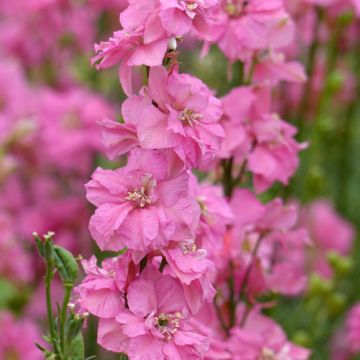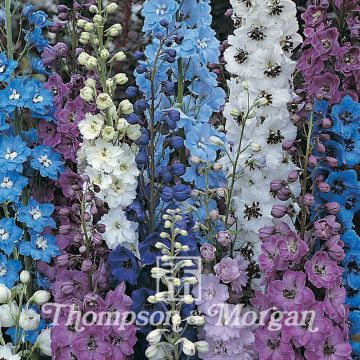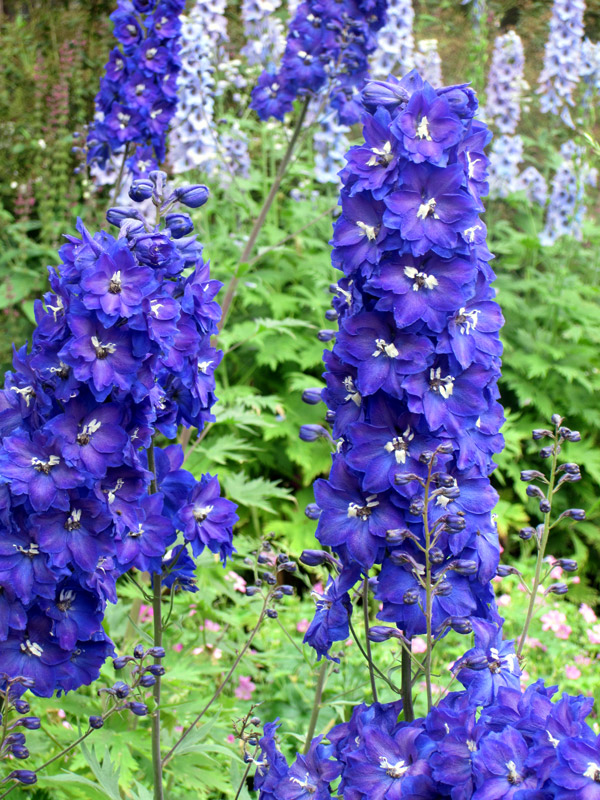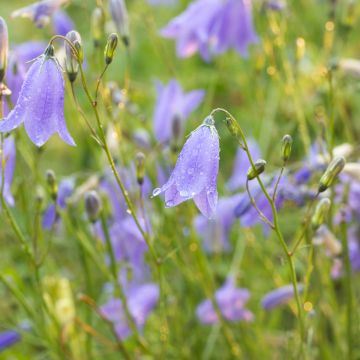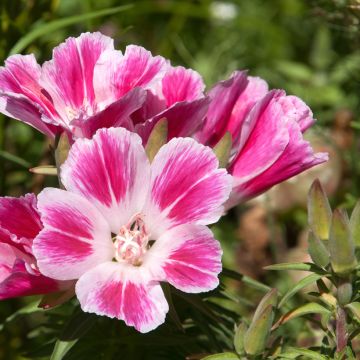

Dwarf Larkspur Summer Blues Seeds - Delphinium grandiflorum


Dwarf Larkspur Summer Blues Seeds - Delphinium grandiflorum
Dwarf Larkspur Summer Blues Seeds - Delphinium grandiflorum
Delphinium grandiflorum Summer Blues
Siberian Larkspur, Chinese Delphinium
Special offer!
Receive a €20 voucher for any order over €90 (excluding delivery costs, credit notes, and plastic-free options)!
1- Add your favorite plants to your cart.
2- Once you have reached €90, confirm your order (you can even choose the delivery date!).
3- As soon as your order is shipped, you will receive an email containing your voucher code, valid for 3 months (90 days).
Your voucher is unique and can only be used once, for any order with a minimum value of €20, excluding delivery costs.
Can be combined with other current offers, non-divisible and non-refundable.
Why not try an alternative variety in stock?
View all →This plant carries a 6 months recovery warranty
More information
We guarantee the quality of our plants for a full growing cycle, and will replace at our expense any plant that fails to recover under normal climatic and planting conditions.
Would this plant suit my garden?
Set up your Plantfit profile →
Description
Larkspur 'Summer Blues' is an adorable selection belonging to the renowned “Summer” series. It forms very compact, well-branched plants that displays loose sprays of single, sky blue blooms over attractive green foliage. Early-flowering and prolific, it is ideal for growing at the front of borders and in pots. Direct sow in spring in rich, cool soil, in a sunny, sheltered position.
Delphinium 'Summer Blues' is one of the many hybrids selected from D. grandiflorum, a short-lived perennial (often treated as an annual) that is native to the mountainous regions of China, Siberia, Mongolia and Japan. It self-seeds easily in light soil. This hardy, fast-growing variety forms a wide, dense, 30-35 cm clump in the space of a few months. The leaves are palmately divided or lobed, soft green in colour, topped with 30 cm tall floral stems in summer. Flowering takes place from June to August, even as early as July in warmer climates, repeat flowering in September. The simple, cup-shaped blooms are gathered on loose sprays and are a magnet to foraging insects. They are made up of 5 petals in an eye-catching shade of sky blue.
This unique Delphinium is ideal for smaller gardens. For a romantic touch, it can be used for underplanting old roses and Baby's Breath. The long-lasting, sky blue blooms make lovely bouquets, combining well with white, yellow, orange and pink. It is an excellent variety for growing in pots on the patio or balcony.
Flowering
Foliage
Plant habit
Safety measures
Botanical data
Delphinium
grandiflorum
Summer Blues
Ranunculaceae
Siberian Larkspur, Chinese Delphinium
Cultivar or hybrid
ingestion
Cette plante est toxique si elle est ingérée volontairement ou involontairement.
Ne la plantez pas là où de jeunes enfants peuvent évoluer, et lavez-vous les mains après l'avoir manipulée.
Pensez à conserver l'étiquette de la plante, à la photographier ou à noter son nom, afin de faciliter le travail des professionnels de santé.
Davantage d'informations sur https://plantes-risque.info
Other Delphinium seeds
View all →Planting and care
Sow the seeds of Delphinium Summer Blues directly outdoors, from April to May, in full sun, in a fertile, light, well-drained soil that has been previously prepared. Bury the fine seeds to a depth of 6mm (0.2 in) in small holes spaced 30cm (11.8 in) apart. Keep the soil moist by watering regularly, especially during dry periods. Germination usually takes 14 to 21 days. When the seedlings are large enough to handle, thin them out by planting only one plant every 15cm (5.9 in).
For earlier flowering, sow Delphinium seeds from August to October in 7.5cm (2.8 in) pots filled with good quality compost kept moist. Place the pots in a mini-greenhouse or inside a plastic bag at a temperature of 15-20°C until germination. Once the seedlings have developed, place them in a bright, but cooler location. Overwinter the plants in a cool, bright place protected from frost by watering them sparingly. Transplant them to their final location in the following spring. Water regularly until the plants are fully established.
Regularly remove faded flowers to encourage continuous flowering. Delphiniums prefer sunny locations protected from the wind, as well as a fertile soil rich in organic matter and well-drained. Excessively wet or dry soil is detrimental to the growth and flowering duration of the larkspur. Varieties derived from Delphinium grandiflorum are more resistant to diseases and pests than the large hybrids. They also tolerate heat better.
Sowing period
Intended location
Planting & care advice
This item has not been reviewed yet - be the first to leave a review about it.
Similar products
Haven't found what you were looking for?
Hardiness is the lowest winter temperature a plant can endure without suffering serious damage or even dying. However, hardiness is affected by location (a sheltered area, such as a patio), protection (winter cover) and soil type (hardiness is improved by well-drained soil).

Photo Sharing Terms & Conditions
In order to encourage gardeners to interact and share their experiences, Promesse de fleurs offers various media enabling content to be uploaded onto its Site - in particular via the ‘Photo sharing’ module.
The User agrees to refrain from:
- Posting any content that is illegal, prejudicial, insulting, racist, inciteful to hatred, revisionist, contrary to public decency, that infringes on privacy or on the privacy rights of third parties, in particular the publicity rights of persons and goods, intellectual property rights, or the right to privacy.
- Submitting content on behalf of a third party;
- Impersonate the identity of a third party and/or publish any personal information about a third party;
In general, the User undertakes to refrain from any unethical behaviour.
All Content (in particular text, comments, files, images, photos, videos, creative works, etc.), which may be subject to property or intellectual property rights, image or other private rights, shall remain the property of the User, subject to the limited rights granted by the terms of the licence granted by Promesse de fleurs as stated below. Users are at liberty to publish or not to publish such Content on the Site, notably via the ‘Photo Sharing’ facility, and accept that this Content shall be made public and freely accessible, notably on the Internet.
Users further acknowledge, undertake to have ,and guarantee that they hold all necessary rights and permissions to publish such material on the Site, in particular with regard to the legislation in force pertaining to any privacy, property, intellectual property, image, or contractual rights, or rights of any other nature. By publishing such Content on the Site, Users acknowledge accepting full liability as publishers of the Content within the meaning of the law, and grant Promesse de fleurs, free of charge, an inclusive, worldwide licence for the said Content for the entire duration of its publication, including all reproduction, representation, up/downloading, displaying, performing, transmission, and storage rights.
Users also grant permission for their name to be linked to the Content and accept that this link may not always be made available.
By engaging in posting material, Users consent to their Content becoming automatically accessible on the Internet, in particular on other sites and/or blogs and/or web pages of the Promesse de fleurs site, including in particular social pages and the Promesse de fleurs catalogue.
Users may secure the removal of entrusted content free of charge by issuing a simple request via our contact form.
The flowering period indicated on our website applies to countries and regions located in USDA zone 8 (France, the United Kingdom, Ireland, the Netherlands, etc.)
It will vary according to where you live:
- In zones 9 to 10 (Italy, Spain, Greece, etc.), flowering will occur about 2 to 4 weeks earlier.
- In zones 6 to 7 (Germany, Poland, Slovenia, and lower mountainous regions), flowering will be delayed by 2 to 3 weeks.
- In zone 5 (Central Europe, Scandinavia), blooming will be delayed by 3 to 5 weeks.
In temperate climates, pruning of spring-flowering shrubs (forsythia, spireas, etc.) should be done just after flowering.
Pruning of summer-flowering shrubs (Indian Lilac, Perovskia, etc.) can be done in winter or spring.
In cold regions as well as with frost-sensitive plants, avoid pruning too early when severe frosts may still occur.
The planting period indicated on our website applies to countries and regions located in USDA zone 8 (France, United Kingdom, Ireland, Netherlands).
It will vary according to where you live:
- In Mediterranean zones (Marseille, Madrid, Milan, etc.), autumn and winter are the best planting periods.
- In continental zones (Strasbourg, Munich, Vienna, etc.), delay planting by 2 to 3 weeks in spring and bring it forward by 2 to 4 weeks in autumn.
- In mountainous regions (the Alps, Pyrenees, Carpathians, etc.), it is best to plant in late spring (May-June) or late summer (August-September).
The harvesting period indicated on our website applies to countries and regions in USDA zone 8 (France, England, Ireland, the Netherlands).
In colder areas (Scandinavia, Poland, Austria...) fruit and vegetable harvests are likely to be delayed by 3-4 weeks.
In warmer areas (Italy, Spain, Greece, etc.), harvesting will probably take place earlier, depending on weather conditions.
The sowing periods indicated on our website apply to countries and regions within USDA Zone 8 (France, UK, Ireland, Netherlands).
In colder areas (Scandinavia, Poland, Austria...), delay any outdoor sowing by 3-4 weeks, or sow under glass.
In warmer climes (Italy, Spain, Greece, etc.), bring outdoor sowing forward by a few weeks.































